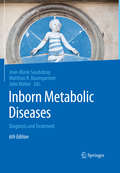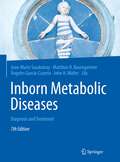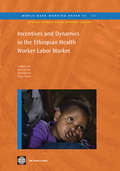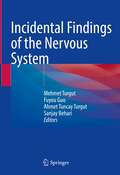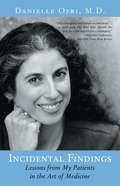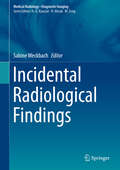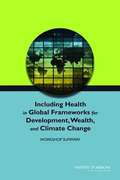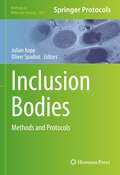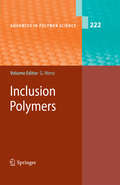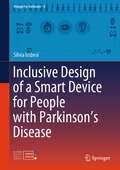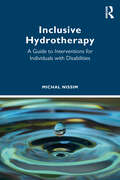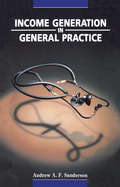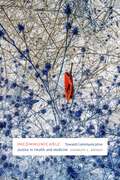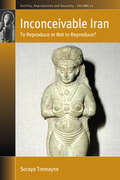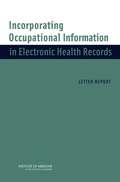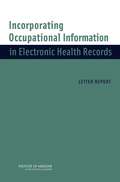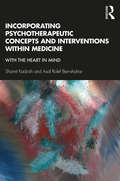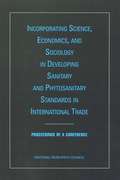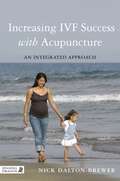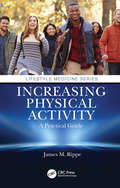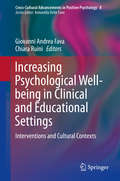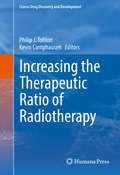- Table View
- List View
Inborn Metabolic Diseases
by John Walter Jean-Marie Saudubray Matthias R. BaumgartnerThis work is recognised as the standard textbook for professionals involved in the diagnosis and management of inborn errors of metabolism (IEM) and an essential resource in this multidisciplinary field. For the 6th edition all 43 chapters have been newly written or revised by authors with particular expertise in their subject areas. Contents: A clinical and biochemical approach to the recognition and diagnosis of IEM with algorithms to symptoms, signs, and syndromes in patients of all ages; Emergency treatments; Medications - Separate comprehensive sections on IEM of: Carbohydrates; Mitochondrial Energy; Amino and organic acids; Vitamin-responsive defects; Neurotransmitter and Small peptides, Lipid and Bile Acids; Nucleic Acid and Heme; Organelles - Disorders affecting the synthesis and remodelling of complex lipids and fatty acid homeostasis are now included.
Inborn Metabolic Diseases: Diagnosis and Treatment
by Jean-Marie Saudubray Matthias R. Baumgartner John H. Walter Ángeles García-CazorlaThis 7th edition is a milestone in the series of Inborn Metabolic Diseases (IMD), recognised as the standard textbook for professionals involved in the diagnosis and management of IMD.Within the last 5 years a Copernican revolution in our understanding of IMD has changed the definition, concepts, paradigms, and classification. This new edition now extends the concept of IMD to include those disturbances in molecular machinery diagnosed by molecular techniques but currently without measurable metabolic markers.The book presents a clinical and biochemical approach to the diagnosis and management of IEM with many diagnostic algorithms for patients of all ages and with a particular focus on neurological presentations. It includes separate, comprehensive sections on IEM classified in 3 major pathophysiological categories: disorders of energy metabolism, both mitochondrial and non-mitochondrial; small molecule disorders, mostly diagnosed with metabolic markers; and complex molecules disorders, mostly diagnosed with molecular techniques.Two new chapters were added, describing around 600 disorders of nucleic acid metabolism, tRNA metabolism, ribosomal biogenesis, and cellular trafficking.
Incarnate: A Novel
by Josh StolbergAn ambitious and sharp-witted clinical psychiatrist turns detective when one of her patients comes under investigation for a series of brutal murders—is she a psychopath or a victim herself?Brilliant psychiatric resident Dr. Kim Patterson has one major flaw: she is too committed to her patients. Her willingness to break the rules and use unconventional methods to help her patients heal has already gotten her thrown out of several hospitals. And when Scarlett Hascall is brought into the psychiatric ward, Kim can’t resist getting involved, even if it means breaking protocol—because Kim can see what the other doctors cannot. Scarlett is suffering from a rare condition: Dissociative Identity Disorder, otherwise known as Multiple Personalities. But even Kim is at a loss when she realizes that some of Scarlett’s alternate identities are claiming to be people who have gone missing from their town. And when Scarlett’s alter identity “Izzi” knows way too much about the whereabouts of the missing Isabel Wilcox, the police begin to suspect that Scarlett may have been involved with Isabel’s disappearance. Only Kim defends Scarlett, certain of the girl’s innocence. But her new theory is a radical one, one she can hardly believe herself: What if Kim is channeling the troubled souls of these victims? With the help of local police officer Zack Trainor, Kim digs further into Isabel’s case, trying to find proof that Scarlett wasn’t involved. The more they discover, the more it becomes apparent that something strange and frightening is going on with Scarlett. Is it possible she is truly harboring lost souls? Or is Scarlett playing a twisted game with her doctors and the police?
Incentives and Disincentives in Organ Donation: A Multicultural Study among Beijing, Chicago, Tehran and Hong Kong (Philosophy and Medicine #133)
by Ruiping FanThis book provides the first systematic study on three types of incentives for organ donation. It covers extensive research conducted in four culturally different societies: Hong Kong, mainland China, Iran and the United States, and shows on the basis of the research that a new model of incentives can be constructed to enhance organ donation in contemporary societies. The book focuses on three types of incentives: honorary incentives, commonly adopted in the United States and other Western countries by offering things such as a thank-you card and a memorial park for donors to encourage donations motivated by pure altruism; compensationalist incentives, adopted in the Islamic Republic of Iran to encourage donation by providing monetary compensation to unrelated living donors for appreciating their altruistic contribution of donation; and familist incentives, implemented in Israel and mainland China to provide priority to organ transplantation to donors and/or their family members. The book demonstrates that a new model of incentives must go beyond offering only one type of incentives and should rather include different types of incentives that are practically effective, politically legitimate and ethically justifiable for particular societies. This implies that suitable incentive measures may vary from society to society to optimize organ donation. This book provides a clear reference for both the scholars and practitioners in the field of organ transplantation, as well as for general readers interested in bioethics and health care policy.
Incentives and Dynamics in the Ethiopian Health Worker Labor Market
by Agnes Soucat William Jack Joost De Laat Kara HansonBy international standards, health workers in Ethiopia are in short supply. In addition, those who do enter the health fields and remain in the country disproportionately live and work in the capital, Addis Ababa. This paper uses detailed data gathered from nearly 1,000 health workers to examine the incentives and constraints that health workers face when choosing where to work, the likely responses of workers to alternative incentive packages, and the longer term performance of the health worker labor market. This working paper was produced as part of the World Bank's Africa Region Health Systems for Outcomes (HSO) Program. The Program, funded by the World Bank, the Government of Norway, the Government of the United Kingdom and the Global Alliance for Vaccines and Immunization (GAVI), focuses on strengthening health systems in Africa to reach the poor and achieve tangible results related to Health, Nutrition and Population. The main pillars and focus of the program center on knowledge and capacity building related to Human Resources for Health, Health Financing, Pharmaceuticals, Governance and Service Delivery, and Infrastructure and ICT.
Incentives for Global Public Health
by Kim Rubenstein Thomas Pogge Matthew Rimmer"This portrait of the global debate over patent law and access to essential medicines focuses on public health concerns about HIV/AIDS, malaria, tuberculosis, the SARS virus, influenza, and diseases of poverty. The essays explore the diplomatic negotiations and disputes in key international fora, such as the World Trade Organization, the World Health Organization and the World Intellectual Property Organization. Drawing upon international trade law, innovation policy, intellectual property law, health law, human rights and philosophy, the authors seek to canvass policy solutions which encourage and reward worthwhile pharmaceutical innovation while ensuring affordable access to advanced medicines. A number of creative policy options are critically assessed, including the development of a Health Impact Fund, prizes for medical innovation, the use of patent pools, open-source drug development and forms of 'creative capitalism'"--Provided by publisher.
Incidental Findings of the Nervous System
by Ahmet Tuncay Turgut Mehmet Turgut Fuyou Guo Sanjay BehariWritten and edited by leading international authorities in the field, this book provides an in-depth review of knowledge of the incidental findings of the nervous system, with emphasis on asymptomatic brain and spinal lesions that have the potential to cause illness. It includes very informative chapters, organized into four main groups: first, incidental findings of the brain and cranium, including intracranial, intraventricular and skull base lesions, infarcts and calcification; secondly, incidental findings of the spine and spinal cord, including spinal cord tumors, syringomyelia, arteriovenous malformations and craniovertebral junction anomalies; thirdly, incidental findings of the spinal nerves and peripheral nerves, including tumors of the plexi and peripheral nerves; and fourthly, other lesions, including acquired incidental lesions of the brain and spine as well as the medicolegal and psychiatric aspects related to these lesions. The uniqueness of this compilation lies in the fact that several abnormalities exist in the nervous system that have the potential to cause life threatening illness; yet because they are asymptomatic and incidental, this leads to major management dilemmas related to whether or not to surgically the lesion. The proponents of an early surgical management subscribe to the philosophy that getting rid of an entity earlier on when it is asymptomatic, leads to an early cure and obviates any risk of it becoming aggressive and incurable later on; those opting for a ‘wait and watch’ policy subscribe to the view that no intervention (as well as subjecting the patient to the risk of surgery) is mandated until the lesion becomes symptomatic. This may subject a person to a lifetime of anxiety related to how that lesion is going to evolve, when in all likelihood, the subject may remain asymptomatic throughout his/her life. The psychological aspects of the patient who is extremely disturbed by the presence of this incidental lesion; and, who cannot adjust to the reality that the treating doctor actually does not have a well-defined plan for it, are issues that are adequately addressed with clinical illustrations and examples. This comprehensive reference book will be an ideal source for neuroscientists at all levels, from graduate students to researchers in specific disciplines studying this region, including neurosurgeons, neurologists, neuroradiologists, neuropathologists and psychiatrists, who seek both basic and more advanced information regarding the incidental findings of the nervous system.
Incidental Findings: Lessons from My Patients in the Art of Medicine
by Danielle OfriIn Singular Intimacies, which the New England Journal of Medicine said captured the "essence of becoming and being a doctor," Danielle Ofri led us into the hectic, constantly challenging world of big-city medicine. In Incidental Findings, she's finished her training and is learning through practice to become a more rounded healer. The book opens with a dramatic tale of the tables being turned on Dr. Ofri: She's had to shed the precious white coat and credentials she worked so hard to earn and enter her own hospital as a patient. She experiences the real'slight prick and pressure' of a long needle as well as the very real sense of invasion and panic that routinely visits her patients.These fifteen intertwined tales include "Living Will," where Dr. Ofri treats a man who has lost the will to live, and she too comes dangerously close to concluding that he has nothing to live for; "Common Ground," in which a patient's difficult decision to have an abortion highlights the vulnerabilities of doctor and patient alike; "Acne," where she is confronted by a patient whose physical and emotional abuse she can't possibly heal, so she must settle on treating the one thing she can, the least of her patient's problems; and finally a stunning concluding chapter, "Tools of the Trade," where Dr. Ofri's touch is the last in a woman's long life.From the Hardcover edition.
Incidental Radiological Findings
by Sabine WeckbachThis book covers incidental radiological findings (IFs) from different perspectives, provides interesting ethical background information, highlights the differences between IFs in clinical routine and during research studies, explains the management of IFs with reference to practices in different countries, and presents information on follow-up and statistical methods. The prevalence of IFs is increasing due to the wider use of modern imaging modalities in routine clinical practice and large population-based cohort studies. The reporting of these findings may lead to further diagnostic investigations and treatment and must therefore be handled with knowledge and care. The management of IFs in clinical routine is regulated by the guidelines of the different academic societies, while management in the setting of research studies depends on a variety of factors. In general, IFs must be disclosed to the imaged subject if they are potentially clinically relevant, but subjects must also be protected from the consequences of false positive findings. This book, written by distinguished experts in their fields, discusses all these issues and will be of interest to radiologists, other clinicians, and radiographers/technicians.
Including Health in Global Frameworks for Development, Wealth, and Climate Change: Workshop Summary
by Suzanne Landi"Including Health in Global Frameworks for Development, Wealth, and Climate Change" is the summary of a three-part public webinar convened by the Institute of Medicine Roundtable on Environmental Health Sciences, Research, and Medicine and its collaborative on Global Environmental Health and Sustainable Development. Presenters and participants discussed the role of health in measuring a country's wealth (going beyond gross domestic product), health scenario communication, and international health goals and indicators. The workshop focused on fostering discussion across academic, government, business, and civil society sectors to make use of existing data and information that can be adapted to track progress of global sustainable development and human health. This report examines frameworks for global development goals and connections to health indicators, the role for health in the context of novel sustainable economic frameworks that go beyond gross domestic product, and scenarios to project climate change impacts.
Inclusion Bodies: Methods and Protocols (Methods in Molecular Biology #2617)
by Julian Kopp Oliver SpadiutThis detailed volume presents a series of protocols dealing with different aspects of inclusion body (IB) processing, from cloning procedures to purification of refolded product. Commencing with chapters on upstream processing, looking into different expression strategies for IB production, the book continues with downstream applications, highlighting early protein purification and subsequent analytics, as well as success stories of IB-based processes. Written for the highly successful Methods in Molecular Biology series, chapters include introductions to their respective topics, lists of the necessary materials and reagents, step-by-step and readily reproducible laboratory protocols, and tips on troubleshooting and avoiding known pitfalls. Authoritative and practical, Inclusion Bodies: Methods and Protocols serves as an ideal resource for facilitating diverse aspects of IB processing.
Inclusion Polymers
by Gerhard WenzThis book contains short and concise reports on physics and chemistry of polymers, each written by the world renowned experts. The book has the highest Impact Factor of all journals ranked by ISI within Polymer Science.
Inclusive Design of a Smart Device for People with Parkinson’s Disease (Design For Inclusion #4)
by Silvia ImbesiThis book reports on an inclusive design project aimed at developing IoT-based wearable devices for special populations. Specifically, it covers the design, the implementation and testing of a smart mHealth system that uses sensory cues to monitor and train the gait and posture of people with Parkinson’s disease. It presents a user-centred strategy to better involve the users in defining the most suitable type of sensory cues and their combination, and in the design of the user interface, at the purpose of developing a gait tutoring system that better fits users’ needs and requirements. All in all, this book offers extensive information on the state-of-the-art in the design and testing of innovative user-centred mHealth systems. Giving a particular attention to the explanation of the tools and methodological choices, it provides readers with a timely reference guide to understand and deal with complex inclusive design projects.
Inclusive Hydrotherapy: A Guide to Interventions for Individuals with Disabilities
by Michal NissimThis text provides a comprehensive introduction to using hydrotherapy as a means of promoting autonomy and social inclusion for individuals with disabilities.Reflecting the global transition from predominantly medical models of disability towards more inclusive and empowering approaches, the book presents the Four-Dimensional Model of Hydrotherapy – a conceptual framework that integrates physical functioning, sensory experience, positive identity development, and long-term well-being. With an evidence-based approach throughout, and informed by key hydrotherapy principles, the book synthesises current research across disability studies, rehabilitation sciences, and inclusive education. Structured case studies and applied examples illustrate how hydrotherapy can address challenges such as accessibility, staff training, and communication barriers, ensuring that interventions remain responsive across a range of settings.This book will be of particular interest to allied health professionals working in physiotherapy, occupational therapy, speech and language therapy, and beyond. By bridging theory and practice, it provides a valuable resource for delivering inclusive, person-centred hydrotherapy aligned with contemporary disability rights frameworks.
Income Generation in General Practice
by Andrew A Sanderson'When I want to know the real rock-bottom truth about what happens all the time in this doctoring life what happens to us and to the folks who bring us their hearts and worries to be heard that's when I turn every time to the novelists the playwrights the poets the essayists who have given us the sights and sounds the feel of all that goes on minute by minute. What Tolstoy and Chekhov knew we need to know for ourselves for our own sakes as we live out our medical lives.' William Carlos Williams 'The most fundamental of all consulting skills is genuine curiosity about other people the constant urge to wonder 'Why are they as they are?' We should open our minds to the life of the imagination not just for its entertainment value but for the mindset of curiosity it engenders in us. Such books as John Salinsky describes in this and his previous volume combine powerful opportunities for our own professional growth with pleasure and recreation too.' Roger Neighbour in his Foreword 'This carefully assembled wonderfully telling book is a "companion" for sure a lasting and most helpful one for the medical travelling that awaits us.' Robert Coles in his Foreword
Incommunicable: Toward Communicative Justice in Health and Medicine
by Charles L. BriggsIn Incommunicable, Charles L. Briggs examines the long-standing presumptions that medical discourse translates easily across geographic, racial, and class boundaries. Bringing linguistic and medical anthropology into conversation with Black and decolonial theory, he theorizes the failure in health communication as incommunicability, which negatively affects all patients, doctors, and healthcare providers. Briggs draws on W. E. B. Du Bois and the work of three philosopher-physicians—John Locke, Frantz Fanon, and Georges Canguilhem—to show how cultural models of communication and health have historically racialized people of color as being incapable of communicating rationally and understanding biomedical concepts. He outlines incommunicability through a study of COVID-19 discourse, in which health professionals defined the disease based on scientific medical knowledge in ways that reduced varieties of nonprofessional knowledge about COVID-19 to “misinformation” and “conspiracy theories.” This dismissal of nonprofessional knowledge led to a failure of communication that eroded trust in medical expertise. Building on efforts by social movements and coalitions of health professionals and patients to craft more just and equitable futures, Briggs helps imagine health systems and healthcare discourses beyond the oppressive weight of communicability and the stigma of incommunicability.
Inconceivable Iran: To Reproduce or Not to Reproduce? (Fertility, Reproduction and Sexuality: Social and Cultural Perspectives #50)
by Soraya TremayneCelebrating the 50th volume of the landmark Fertility, Reproduction and Sexuality series, this book offers a much-needed analysis of shifting reproductive policies and practices in the Islamic Republic of Iran, a society that is usually represented as either “revolutionary” or “oppressive.” Instead, Tremayne reflects on more than four decades of research arguing that changing reproductive behaviors on the part of ordinary Iranians must always be viewed against the backdrop of core cultural values and traditions, which are often reinforced, instead of radically altered, by new reproductive technologies, juridical opinions, and state policies.
Incorporating Occupational Information in Electronic Health Records: Letter Report
by Linda Hawes CleverEach year in the United States, more than 4,000 occupational fatalities and more than 3 million occupational injuries occur along with more than 160,000 cases of occupational illnesses. Incorporating patients' occupational information into electronic health records (EHRs) could lead to more informed clinical diagnosis and treatment plans as well as more effective policies, interventions, and prevention strategies to improve the overall health of the working population. At the request of the National Institute for Occupational Safety and Health, the IOM appointed a committee to examine the rationale and feasibility of incorporating occupational information in patients' EHRs. The IOM concluded that three data elements - occupation, industry, and work-relatedness - were ready for immediate focus, and made recommendations on moving forward efforts to incorporate these elements into EHRs.
Incorporating Occupational Information in Electronic Health Records: Letter Report
by The National Academy of SciencesEach year in the United States, more than 4,000 occupational fatalities and more than 3 million occupational injuries occur along with more than 160,000 cases of occupational illnesses. Incorporating patients' occupational information into electronic health records (EHRs) could lead to more informed clinical diagnosis and treatment plans as well as more effective policies, interventions, and prevention strategies to improve the overall health of the working population. At the request of the National Institute for Occupational Safety and Health, the IOM appointed a committee to examine the rationale and feasibility of incorporating occupational information in patients' EHRs. The IOM concluded that three data elements - occupation, industry, and work-relatedness - were ready for immediate focus, and made recommendations on moving forward efforts to incorporate these elements into EHRs.
Incorporating Psychotherapeutic Concepts and Interventions Within Medicine: With the Heart in Mind
by Shamit Kadosh Asaf Rolef Ben-shaharThis book provides doctors with insights into psychological and relational dynamics to better understand themselves and their patients, deepen their understanding of somatic and psychic dimensions of illness, and give them diagnostic and therapeutic tools to design better treatment procedures for patients. In the first part of the book, the authors explore cognitive, emotional, and somatic strategies that are supportive of doctors’ well-being. In the second part, they introduce theoretical knowledge and applicable skills from psychotherapy that can illuminate the complexity of the doctor-patient relationship, broaden doctors' approaches, and upgrade their communicative skills. The third part introduces some of the basic tenets of somatic psychotherapy that can deepen doctors' understanding of symptoms and illness, providing them with richer therapeutic tools and a deeper knowledge of bodily and psychological aspects, interweaving in a variety of medical conditions. This text not only provides a helping hand to both doctors and psychotherapists in designing an amalgamated approach to clinical treatment but also provides doctors with better tools for understanding and managing the intricacies of the doctor-patient relationship.
Incorporating Science, Economics, and Sociology in Developing Sanitary and Phytosanitary Standards in International Trade: Proceedings of a Conference
by Board On Agriculture Natural ResourcesThe National Academies Press (NAP)--publisher for the National Academies--publishes more than 200 books a year offering the most authoritative views, definitive information, and groundbreaking recommendations on a wide range of topics in science, engineering, and health. Our books are unique in that they are authored by the nation's leading experts in every scientific field.
Increasing IVF Success with Acupuncture: An Integrated Approach
by Nick Dalton-BrewerThis practical book provides need-to-know information vital for acupuncturists to treat patients with fertility problems. Nick Dalton-Brewer details the causes of fertility issues, including the impact of lifestyle and diet, and explains the scientific basis for the different methods of treatment. Integrating Assisted Reproduction Techniques (ART) with Traditional Chinese Medicine (TCM) therapies and acupuncture, he presents his own cutting-edge research on the successful use of these therapies to improve fertility and pregnancy rates and describes a method for integrated diagnosis and treatment. This book will give TCM practitioners direct access to the vital specialist knowledge and technical information needed to treat the increasing numbers of patients with fertility problems effectively. It will also be of interest to doctors of Western medicine concerned about the efficacy of recommending acupuncture treatments as adjuncts to ART.
Increasing Physical Activity: A Practical Guide (Lifestyle Medicine)
by James M. RippeOnly a fifth of adults in the United States do enough physical activity to meet the guidelines set by Centers for Disease Control. The health benefits of regular physical activity are beyond dispute, yet less than 40% of physicians routinely counsel their patients on the importance of physical activity. Increasing Physical Activity: A Practical Guide equips healthcare practitioners to include physical activity counseling in the daily practice of medicine. Written by lifestyle medicine pioneer and cardiologist, Dr James Rippe, this book proves inactivity is a stronger risk factor than other lifestyle factors for cardiovascular disease, diabetes, and many other diseases. It provides evidence-based information on the role of physical activity in preventing and treating chronic conditions and includes practical strategies for healthcare practitioners to prescribe this powerful method to enhance both short and long-term health and quality of life. Features: Specific chapters explain the role of physical activity in reduction of risk of heart disease, diabetes, cancer, osteoarthritis, dementia and many other chronic conditions. Chapters begin with bulleted, key points and conclude with a list of clinical applications. Strategies are provided to encourage previously sedentary individuals to adopt regular physical activity. Physical activity is placed in the context of other lifestyle medicine concepts including maintenance of a healthy body weight, following sound nutritional practices, stress reduction and other practices which impact on health and quality of life. Written for healthcare practitioners at all levels, this is a user-friendly, evidence-based manual for healthcare practitioners looking to incorporate more physical activity counseling into either general medicine or subspecialty practices.
Increasing Psychological Well-being in Clinical and Educational Settings
by Giovanni Andrea Fava Chiara RuiniThis volume deals with strategies aimed at increasing psychological well-being in both clinical and non-clinical settings, with a special focus on the impact of cross-cultural influences on these processes. Consisting of two parts, the book first examines clinical interventions for increasing well-being and positive functioning in adult populations. It looks at cultural differences in the experience of psychological well-being, presents an analysis of the concept of psychological well-being and discusses various interventions, including Well-Being Therapy and Cognitive Behavioral Therapy. Other concepts discussed are post-traumatic growth, wisdom and motivation. The second part of the book deals with psychological interventions in childhood and adolescence and has a strong emphasis on educational settings. It provides an overview of the main evidence-based psychotherapies for affective disorders in youths, and looks at the importance and impact of positive education, resilience, and hope. The book presents models for intervention and discusses several therapies in detail.
Increasing the Therapeutic Ratio of Radiotherapy
by Philip J. Tofilon Kevin CamphausenCurrent cancer therapies are focused on three general strategies: modifying intrinsic radiosensitivity via molecular targeting, manipulating microenvironmental factors to enhance tumor susceptibility to radiation, and improving delivery of radiation to critical tumor locations while sparing normal tissues. The goal of this volume is to describe a number of promising approaches corresponding to each strategy. In general, research in radiation oncology tends to be siloed into fundamental biology, physics or treatment delivery. The strategies for improving therapeutic ratio encompassed in this book will involve each of these components of radiation oncology. Thus, they will illustrate the variety of disparate approaches available for potentially improving the efficacy of radiotherapy, which may then stimulate discussion across disciplines and foster further translational investigations. Although a goal of each chapter will be to highlight advances within an approach, of equal importance will be the delineation of barriers to successful clinical application and how to overcome or minimize such impediments. Along these lines, because therapeutic ratio incorporates both tumor and normal tissue radio response, a point of emphasis will be the mechanistic rationale for selectively modifying tumor (sensitization) or normal cells (protection). Finally, whereas the literature is replete with studies describing potential targets/strategies for increasing the therapeutic ratio for radiotherapy, this book will focus on those supported by in vivo data consistent with impending translational application along with those that are already being evaluated in the clinic.
